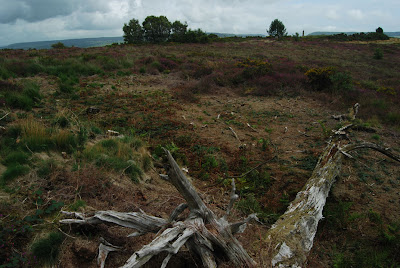









I get off the bus on Aylesbeare Common, a couple of miles outside of Aylesbeare village to have a short detour from my main walk, which will be walking back over the distant hills into town.
Aylesbeare (pop.527) is only famous in this country for one thing and that is the disappearance on 19th August 1978 of Genette Tate http://www.bbc.co.uk/devon/news_features/2003/genette_tate_25.shtml when she went missing aged 13 whilst delivering newspapers. Her bicycle and scattered newspapers were found lying in the middle of a country lane only minutes after she had been speaking to two friends. Her story was all over the newspapers at the time and still turns up sometimes, although her disappearance remains a mystery and is unsolved, unfortunately.
Aylesbeare (pop.527) is only famous in this country for one thing and that is the disappearance on 19th August 1978 of Genette Tate http://www.bbc.co.uk/devon/news_features/2003/genette_tate_25.shtml when she went missing aged 13 whilst delivering newspapers. Her bicycle and scattered newspapers were found lying in the middle of a country lane only minutes after she had been speaking to two friends. Her story was all over the newspapers at the time and still turns up sometimes, although her disappearance remains a mystery and is unsolved, unfortunately.
I am here in the middle of nowhere to take a look at the tumuli which are marked on the map as being around here somewhere. Actually they turn out to be really easy to find and are very close to the main road indeed. It is strange to think that the bus that I travel to work on and all the traffic that hurtles past this spot are within spitting distance of these tumuli which remain largely ignored by folk here. I myself have hurtled past these tumuli, not knowing of their existence until I was browsing the map one day and spotted them. To find these things all you need is a local map and a bit of curiosity although it does help that there are lots of these things around here. I have in years past found similar mounds hidden in woodland which were not marked on any map which I suppose must mean that they are still undiscovered.
I like to stand on them and survey the countryside around to see in what way they might relate to the landscape, markers on distant hills, gaps in hills, prominent trees, stones etc. and this facility is good here as the tumuli have been recently cleared of growth. This is quite unusual as most are left to grow over and so it is a good opportunity to have a look at the unadorned shape of the tumuli and also their possible relationship to the surrounding landscape.
On the next nearest mound stands the remains of a very large tree. This tree, being right on the skyline of Aylesbeare Common was used as a marker for navigational purposes by the sailors of old and was known as The Lone Pine. The tree which though dead remained standing for many years was planned to be felled but a note was found attached to the tree stating that the person who felled the tree would be cursed, the note being signed at the bottom by The White Witches of Aylesbeare. The tree fell of its own accord a few years ago leaving a tall and lovely shaped guardian stump.
Anyway, I take some photographs and must get on. It is a long walk back and the walking hasn't even really started properly yet. The photo's shown here are partly from my second visit, but in the next posting there will be photo's from the remaining part of the original walk in which I have the immense pleasure of seeing the route back from here for the very first time.










